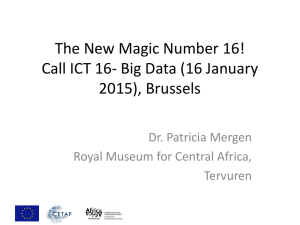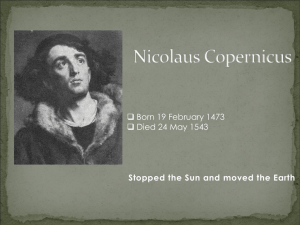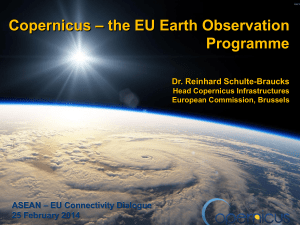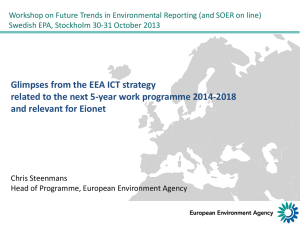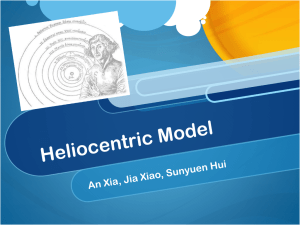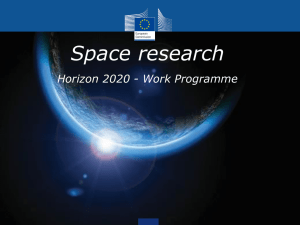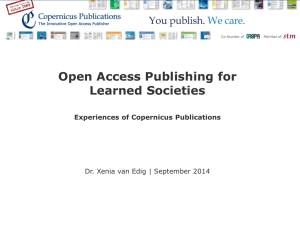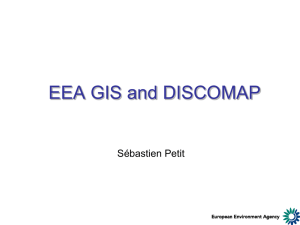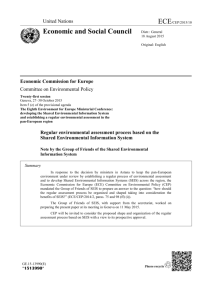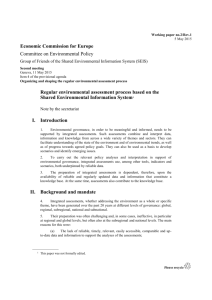The Global Component
advertisement
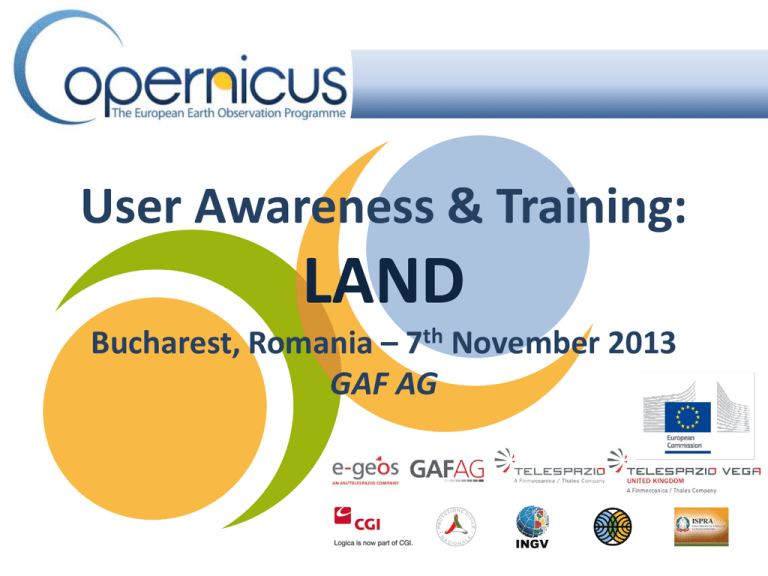
User Awareness & Training: LAND Bucharest, Romania – 7th November 2013 GAF AG Contents Introduction to the COPERNICUS / GMES Land development Further developments – the Sentinels Overview of COPERNICUS/GMES LAND Services and Products: Global Component Continental (= Pan-European) and Local Component In-situ component Summary & Questions Overview of COPERNICUS LAND Services and Products Implementation of GMES / COPERNICUS Land component Research and Development Research and Development Preparatory Actions GIO Initial Operations EU Operational Programme 2004 2005 2009 2011 2013 2023 Overview of COPERNICUS LAND Services and Products The future of the COPERNICUS Land Service Space Segment Sentinels to contribute Main contributions are expected from the Sentinel 2 and 3 optical Satellites: Esp. Sentinel 2 contributing to Land Monitoring through Higher spatial and Higher temporal resolution Data for Global, PAN and Local Products continuation and comparable to LANDSAT Programme for time series (even in the past) Sentinel 3 will contribute to global land monitoring, including jointly with other contributing missions (e.g. PROBA-V) Overview of COPERNICUS LAND Services and Products There are basically four levels of data and products available: Global Land Products Continental or Pan-European Land Products Local Land Products In-situ component Introduction Global Globalcomponent component LAND Components / Core Products: Global JRC bio-geophysical parameters (terrestrial Essential Climate Variables (ter. ECVs), Global LAI: food security (Africa) etc.) Leaf Area EU component Index Continental EEA pan-European products (Corine LC 2012, five HRLs: imperviousness, forest, grassland, wetland, water) Local EEA zooming on ‘hot spots’ (e.g. urban atlas, riparian areas,..) Local component In-situ-component EEA (nat. contribution, Reference: in-situ measures European Environment Agency like hydro-stat. …) Intro – The Global Component Global component Bio-geophysical Parameters derived from Satellite Sensor Data for global and continental monitoring Spatial Resolution of the parameters range: 300m to 5km (Pixel size of Rasterdata rel. to GSD) Spatial Resolution of the parameters range: 300m to 5km (Pixel size of raster data) rel. to Ground Sampling Distance of Satellites Temporal Resolution time series: over several years (past) every 10 days NRT not yet planned but will be an asset High temporal resolution vs. Low spatial resolution for Monitoring and Alerts Source: http://land.copernicus.eu/global/?q=products Auteursrecht 2013 VITO NV Soil Water Index Concept of the Global Component COPERNICUS GLOBAL LAND component is providing global bio-geophysical parameters describing energy fluxes within the general WATER CYCLE. They are contributing to monitor and model the water cycle. Source: R. Lacaze, HYGEOS (2013) and B. Smets, VITO NV(2013) The Global Component Bio-geophysical Parameters: Leaf Area Index (LAI) Fraction of green Vegetation Cover (FCover) Fraction of Absorbed Photosynthetically Active Radiation (FAPAR) Dry Matter Productivity (DMP) Normalized Difference Vegetation Index (NDVI) Vegetation Condition Index (VCI) Vegetation Productivity Index (VPI) Top Of Canopy Reflectances (TOC-r) Surface Albedo (SA) Land Surface Temperature (LST) Soil Water Index (SWI) Burnt Area (BA) Water Bodies (WB) Source: http://land.copernicus.eu/global/?q=products Auteursrecht 2013 VITO NV The Global Component - Example Examples for Global LAND Component Products: Leaf Area Index (LAI) The LAI is defined as half the total area of green elements of the canopy per unit horizontal ground area. Basically, the LAI quantifies the amount of foliage material in an ecosystem. The satellite-derived value corresponds to the total green LAI of the all the canopy layers, including the understory which may represent a very significant contribution, particularly for forests Soil Water Index (SWI) The SWI quantifies the moisture condition within the underlying soil profile. It is mainly driven by the precipitation via the process of infiltration. Soil moisture is a very heterogeneous variable and varies on small scales with soil properties and drainage patterns. Satellite measurements integrate over relative large-scale areas, with the presence of vegetation adding complexity to the interpretation Source: http://land.copernicus.eu/global/?q=products Auteursrecht 2013 VITO NV The Pan-European Component Image Products High Resolution satellite imagery forms the input for the creation of many information products and services; such as land cover maps or high resolution layers on land cover characteristics. Having all the satellite imagery available, it is worthwhile to process the individual image scenes into a seamless pan-European ortho-rectified mosaic. Image 2000 - Image 2006 – Image 2009 – Image 2012 The Pan-European Component Corine Land Cover Land Cover Data Sets of 1990 - 2000 - 2006 – 2012 and Land Cover Changes The Corine Land Cover inventory was initiated in 1985 (reference year 1990). Updates have been produced in 2000 and 2006, and the latest 2012 update is under production. It consists of an inventory of land cover in 44 classes. CLC uses a Minimum Mapping Unit (MMU) of 25 ha for areal phenomena and a minimum width of 100 m for linear phenomena. The time series are complemented by change layers, which highlight changes in land cover with an MMU of 5 ha. Pan-European: Initial Operations Land Services: 5 High-Resolution Layers OPERATIONAL IMPLEMENTATION 2011-2014 CONTRACTED BY THE EUROPEAN ENVIRONMENT AGENCY (EEA) TO INDUSTRIAL CONSORTIAS MAPPING OF 5 THEMATIC “HIGH-RESOLUTION LAYERS” OF LAND COVER FOR ALL OF EUROPE FROM HIGHRESOLUTION OPTICAL EO DATA The GIO-Land services covers 5.8 mio km² in 39 countries (EU-28 + collaborating states + EEA member states) Pan-European Continental Component: HRL’s (1) Pan-European Continental Component: HRL’s (2) The Pan-European Component Bio-geophysical variables Bio-geophysical variables are typically calculated at the beginning of many classification processes. A broad range of variables can be calculated, depending on the thematic domain one is dealing with (e.g. vegetation, energy budget or water cycle). In the context of the panEuropean component of the Copernicus land monitoring service, the NDVI is commonly used for the HRL production. The Local Component URBAN ATLAS Land use and cover data of European urban areas: Cities larger 100,000 inhabitants High Resolution Data (1:10,000, 0,25 rep. 1ha MMU) Years 2006 and 2012 (under preparation) Purpose mainly on urban planning e.g. Information on risks and opportunities Improvement and infrastructure needs Riparian Zones (not yet available) The Local Component The In-Situ Component In-Situ Component is managed by EEA Source: http://sdi.eea.europa.eu/catalogue/srv/eng/search?uuid=e2cac092-4cbf-4765-a06e-0271f382d4a4 EU-DEM is a 3D raster dataset with elevations captured at 1 arc second postings (2.78x10-4 degrees) or about every 30 metres. Hybrid product based on SRTM and ASTER GDEM data fused by a weighted averaging approach. Feedback Forms & Questions

